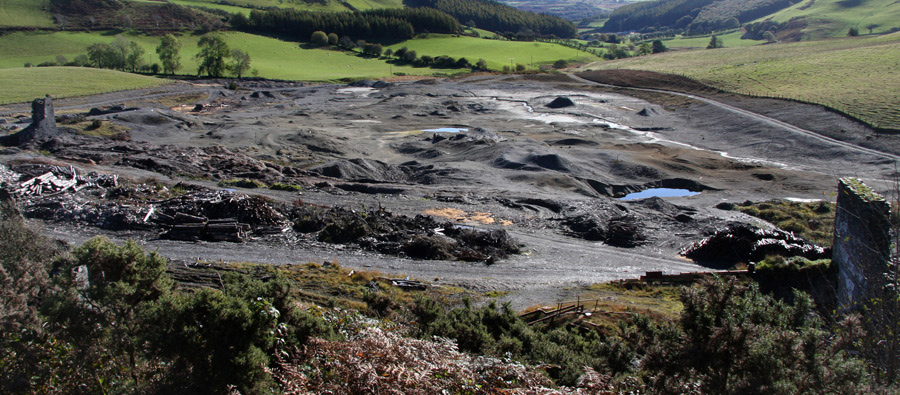Frongoch mine, 17 km south east of Aberystwyth in central Wales, was once one of the most productive mines in Wales, employing hundreds of people from as far afield as Italy. The mine produced lead and zinc ore from 1798 until its closure in 1904, when it fell into disuse, although the large waste dumps left on site were reprocessed to extract metals between 1917 and 1930. Some of the material was transported by aerial ropeway to a mill at Gwaith Goch mine in the Ystwyth valley, while the rest was processed by electrolysis or flotation on site.
In recent decades, water draining from underground workings and waste dumps at the site has carried several tonnes of toxic metals each year into two tributaries of the River Ystwyth: the Nant Cwmnewydion (>Afon Magwr >Ystwyth) to the west of the mine and the Frongoch Stream (>Nant Cell >Ystwyth) to the south. These metals have had a severe impact on the ecology of these streams, which are virtually fishless within 2-3 km of the mine. There are at least 1,300 old metal mines in Wales, causing pollution to more than 600km of rivers and streams, so tackling pollution from abandoned mines is one of the biggest challenges for Natural Resources Wales (NRW).
Frongoch Mine in 2010, before remediation
In 2011, NRW's predecessor, Environment Agency Wales, diverted the Frongoch Stream to stop it flowing into the mine and to reduce the amount of metals-polluted water discharging from the underground workings. The diversion reduced the flow discharging to the Nant Cwmnewydion via the Frongoch Adit by 80% and also diluted the metals in the Frongoch Stream. This work was funded by the Welsh Government's Contaminated Land Capital Fund. Following completion of this work, an application was made for European funding to deal with the pollution coming from the waste dumps.
The Frongoch Mine Remediation Project commenced in 2013 and was successfully completed in June 2015. The £1.15 million project was partly funded by the European Regional Development Fund, provided by Welsh Government, and was delivered by NRW with technical support from the Coal Authority. The project aim was to prevent rain and surface water from coming into contact with the contaminated mine waste, thus reducing the amount of metals being mobilised and entering recipient watercourses.
In the first phase of the project, in 2013, a drainage channel was created to divert water away from the contaminated mine waste and an attenuation pond was built to ensure that this diverted water did not increase the risk of flooding downstream.
In the second phase, in 2015, the contaminated waste dumps were re-shaped and capped with clay and soils to prevent water ingress and to encourage re-vegetation. Drainage channels were built to carry the clean surface water into a series of ponds, creating a wetland habitat for wildlife. The works were designed to preserve the extensive archaeological remains present at the mine. Dyfed Archaeological Trust carried out investigations and recorded the features discovered during excavation of the mine waste.
Frongoch Mine in 2015, after remediation
Investigations in 2017 by NRW and students from Swansea and Aberystwyth universities showed that while the remediation work had reduced metal concentrations in the Frongoch Stream, residual discharges from groundwater discharges and uncapped areas were still causing an impact. Further funding was therefore obtained from the Welsh Government to extend the capping using a geosynthetic clay liner (GCL) and soil, to hydroseed steeper areas of the site and to trial an electrochemical system to treat the residual groundwater discharges. The capping was completed in July 2018, followed by hydroseeding in September 2018. The treatment trial was carried out between January and May 2018 and achieved high metal removal rates. In July 2018, NRW commissioned a study to further assess the feasibility of treating the residual groundwater discharges from Frongoch Mine, including the Frongoch Adit.
The River Ystwyth is important for anglers and tourism. The work completed to date has reduced the amount of contaminated water that flows from Frongoch Mine and reduced metal concentrations downstream. Results of monitoring to date have been encouraging, but NRW will need to continue to monitor the water quality and ecology to fully assess the effectiveness of the remediation work.

